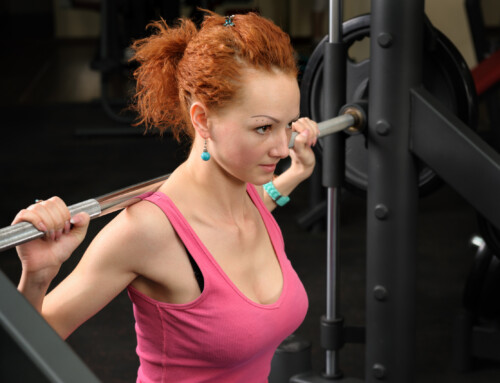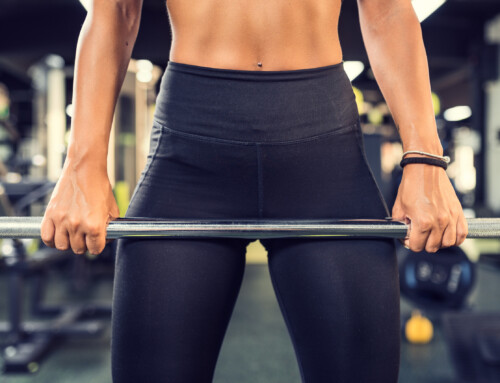
Training with weights will provide remarkable results for women over 50 who are plus sized.
Overweight women 50+ can just as easily pick up a dumbbell or barbell as thinner women in this age group.
There are many benefits from strength training for plus size women over 50. Every woman needs to lift weights — ESPECIALLY older ones.
“Weight training” is the PC term that refers to, quite simply, lifting weights. Call it what you wish, but it’s the same thing: moving against resistance.
This can be done with any of the following:
- Dumbbell and barbell
- Kettlebell
- Resistance machine
- Heavy medicine ball
- Tension band/tubing
- Suspension straps
- Body weight only (e.g., pushup)
Though plus size women over 50 years of age will struggle with pushups if they’re not trained…realize this: You do NOT have to try pushups.
However, body weight squats are a superb start that you can actually do on the very first try. The issue is how many you can do in a row. Aim for 8, then 12, then 15, then 20.
Strength Training Benefits for Overweight Women 50 Years or Older
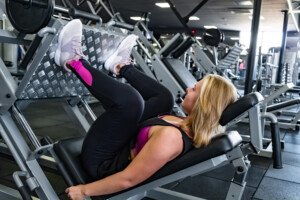
Leg press. Shutterstock/Aleksey Boyko
Though a woman should begin lifting weights much earlier in life, it is never too late to reap the great rewards of exercising against resistance.
Though many women today continue to be averse to the idea of picking up a dumbbell, barbell or even pushing against a stack of metal plates on a sit-down machine, it is women, more so than men, who really need to push and pull against resistance.
This is because women are at a much greater risk of suffering from brittle bone disease (osteoporosis) than are men.
The hormone estrogen has a protective effect against bone loss.
The level of estrogen in a woman’s body drops significantly after menopause, and this heightens her individual risk for losing bone mass.
One way to preserve bone mass is to lift weights. Strength training makes muscles pull at bones.
When muscles pull against bones, this forces the bones to adapt to this stimulus. They adapt by increasing in density (i.e., mass).
Hence, greater bone mass results from weight workouts. The more bone mass a woman has, the less likely she’ll ever suffer a bone fracture.
A second benefit is that strength training will encourage fat loss.
Beginning at around age 30, a woman who has not been weight training begins to lose muscle mass, to the tune of about 5 pounds of muscle per decade.
By the time she’s 50, she’s lost up to 10 pounds of muscle.
Resistance exercise can replace this loss of valuable tissue. Loss of muscle is directly correlated to gain in fat.
In fact, it outright causes fat gain, because muscle requires a lot of energy (calories) just to exist.
If a woman loses muscle, incoming calories get stored as fat because there’s no longer enough muscle mass to use up all those incoming calories.
Does weight training for plus size women over 50 differ from that for trainees much younger?
No, not at all. The same rules apply:
• Warm up
• Practice good form at all times.
• Do mostly compound routines. Compound exercises work several muscle groups at once (examples follow).
• Don’t work the same muscle groups two days in a row.
• Separate weight days from cardio days.
• Lift moderate to heavy weights (whatever feels “moderate” or “heavy” to the trainee).
• Sessions should last 30-60 minutes.
• After warming up, you should do sets with enough resistance to make 8-15 repetitions very challenging.
If the trainee wishes to push even harder (by either using more resistance or by pushing through to the last repetition that’s absolutely possible), that’s great, too.
Some people have more of an “iron will” than others and enjoy pushing to exhaustion. One should not push to exhaustion on every set, however.
• Beginners should spend several weeks using light weights and working at an effort of moderate intensity before advancing to higher intensity.
• Practice progressive overload. This means gradually increase the resistance over time as the muscles and joints get stronger.
• Exhale on the exertion (the push or pull) and deeply inhale on the release. Never hold the breath during a routine.
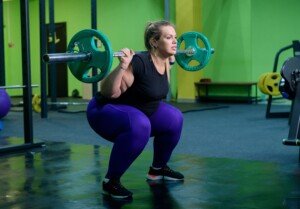
Squat. Shutterstock/Reshetnikov_art
Best compound exercises for building bone, losing fat, toning and strengthening muscles and becoming as physically fit as possible:
• Deadlift (barbell or dumbbell). Works middle and upper back, shoulders, arms, legs, buttocks and core (lower back and abs).
• Squat (barbell, dumbbell, kettlebell). Works legs, buttocks and core; works shoulders when dumbbells and kettlebells are used.
• Leg press. Works buttocks and legs.
• Lat pull-down/seated row/barbell row. Works back and arms.

• Bench press/dumbbell press/pushup. Works chest, shoulders and arms.
• Shoulder barbell/dumbbell press. Works shoulders and arms.
• Clean & press. Works middle and upper back, legs, buttocks, core, shoulders and arms.
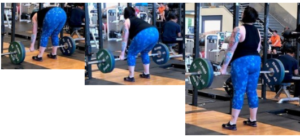
Best isolation exercises. Isolation routines utilize one main muscle group and require action from only one joint. These burn much less fat than do compound exercises.
- Biceps curls with barbell or dumbbell
- Triceps push-downs with a rope and pulley system
- Chest flyes with a “pec deck” machine
- Shoulder side and front raises with dumbbells
- Leg extensions
- Hamstring curls
Being overweight is sometimes used as an excuse to avoid lifting weights.
However, it’s time to see being full-figured as a reason to embrace working out with weights.
 Lorra Garrick is a former personal trainer certified through the American Council on Exercise. At Bally Total Fitness she trained women and men of all ages for fat loss, muscle building, fitness and improved health.
Lorra Garrick is a former personal trainer certified through the American Council on Exercise. At Bally Total Fitness she trained women and men of all ages for fat loss, muscle building, fitness and improved health.
.


